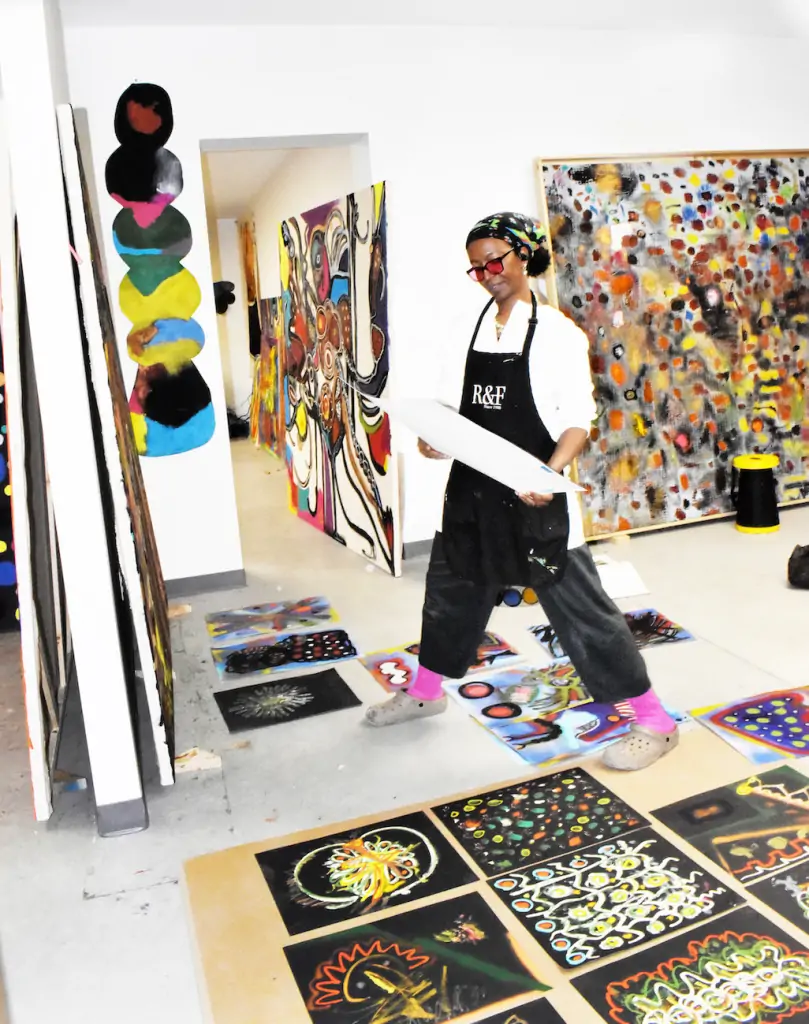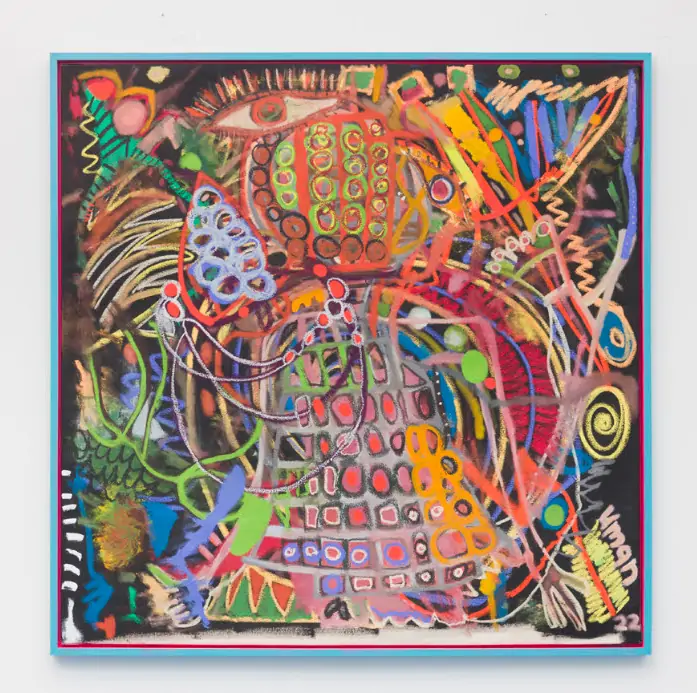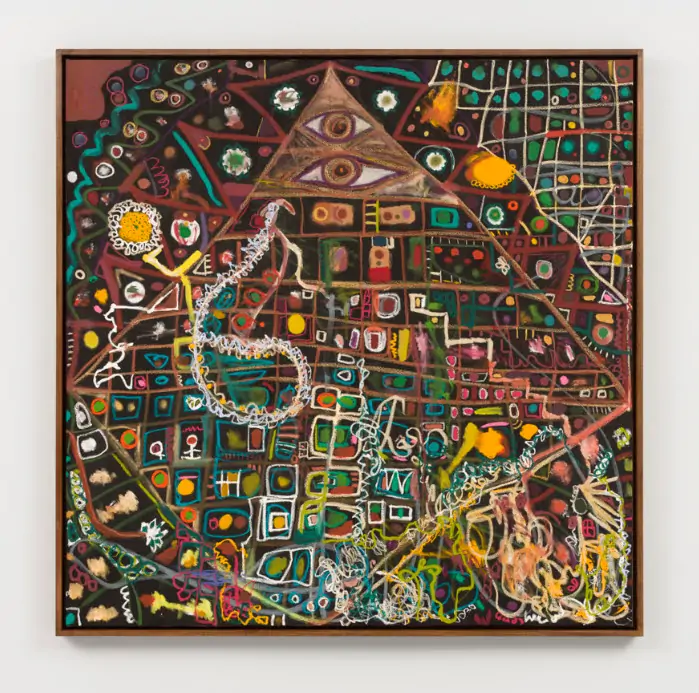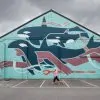Iwan Wirth, Manuela Wirth and Marc Payot, Co-Presidents of Hauser & Wirth, announced today the gallery’s representation of the artist Uman in equal partnership with Nicola Vassell Gallery, NY.
In undertaking this collaboration on behalf of the critically admired Somalia-born, New York based painter and sculptor, Hauser & Wirth and Nicola Vassell hope to model a new kind of alliance between galleries operating at different scales—an approach wherein full transparency and intensive resource sharing can contribute to the further development of artists’ careers and the future health of the wider gallery ecosystem.

©Uman Courtesy the artist, Hauser & Wirth and Nicola Vassell Gallery
Both Nicola Vassell and Hauser & Wirth will present new paintings by Uman in their stands at the forthcoming edition of Art Basel Miami Beach (8 – 10 December). Their first jointly organized exhibition of Uman’s work will open to the public on 30 January 2024 at Hauser & Wirth in London, where the show will remain on view through 1 April 2024.
In October 2025, Uman’s first US museum solo exhibition will open at The Aldrich Contemporary Art Museum in Connecticut, curated by Amy Smith Stewart.
Uman’s ebullient visual vocabulary reflects her expansive cross-cultural experiences. Born in Somalia and raised in Kenya, she emigrated to Denmark as a teenager and later to New York as a young adult. Now living and working in upstate New York, Uman paints lavishly detailed, opulently colored worlds replete with gesture, geometry and evocations of the sublime. While these works are executed primarily with oil paint, she also combines acrylic paint, oil stick and collage techniques.

Acrylic, oil and oil stick on canvas in artist’s frame
189.4 x 189.4 cm / 74 9/16 x 74 9/16 in Photo: Lance Brewer
An intuitive artist and voracious autodidact, Uman draws upon her memories of East African childhood, rigorous education in traditional Arabic calligraphy, deep engagement with dreams, and fascination with kaleidoscopic color and design. With nods to self-portraiture and fictional topographies, Uman’s paintings fluidly navigate in-between realms to explore both the physical and spiritual, intertwining abstraction, figuration, meditative patterning and a reverence for the natural world.
About Uman
Uman was born in Somalia in 1980. She moved with her family to Kenya in 1989 as a result of the Somali Civil War, before relocating to Denmark at the age of 13. From an early age, Uman loved to draw and was fascinated by color and illustration. In the 2000s, when in her 20s, Uman moved to New York City. There, she met Swiss-born, Manhattan-based psychiatrist Annatina Miescher, who encouraged the artist’s intuitive approach to painting and served as a mentor.
In 2015, Uman’s first solo exhibition opened at White Columns, attracting significant attention for her paintings, sculptures and assemblage works that dazzled with their unorthodox and wholly original approach to layering cross-cultural, art historical and textile-based references. As poet and critic Ilka Scobie explained, ‘[Uman] embodies a fluidity that transcends borders, genders, abstraction, and figuration’.
Uman’s work synthesizes the various cultures in which she has lived, with her experiences finding their way into recurring motifs: animals of the East African desert, patterns evoking Somalian hand-woven fabrics, Nordic environments from her time in Denmark, the urban landscape of Manhattan, the starry skies in upstate New York. Since 2020, Uman has divided her time between Albany and the rural community of Roseboom, places that together form the center of her life and work. The natural world continues to directly inform her art through the physical and psychological shifts of the landscape, contributing to her fictional topographies.

Acrylic, oil and oil stick on canvas 158.8 x 159.7 cm / 62 1/2 x 62 7/8 in
Photo: Lance Brewer
The element of self-portraiture permeates Uman’s practice. As she says, ‘I think everything I do now is a self-portrait in different ways. Even my abstract paintings, mythical in nature, are self- portraits. I love drama, and so I depict myself with several mouths, and several eyes, just like a creature.’ This kind of autobiographical transfiguration is seen in works such as ‘Grand Dame Uman’ (2022) and ‘Hell in Heels’ (2022). ‘Amapiano Dance’ (2022-23) is a visual evocation of a well-known genre of South African dance music beloved by the artist—an indirect portrait of the sources of inspiration that give shape to her life and imagination.
Uman privileges saturated colors, combining bright jewel tones alongside darker hues in surprising ways. Her mastery of pigments makes possible a trajectory between past and present. ‘They come from my past,’ she explains. ‘I grew up with colorful women, a colorful culture. East African and Somali people love color more than anything. I’ve kept that in me, living here in the West, and I’m using that in my work to tell a story’. The artist’s process begins with the repeated layering of these colors, followed by a removal of paint via minimal but resolute gestures. This approach heightens the materiality of Uman’s works. ‘I find beauty in the canvas itself,’ she has said about the practice of leaving some of her canvases unprimed. ‘It’s a beautiful strong material that sometimes needs to participate in the painting’.
In addition to prolific iconography from her own memories and dreams, Uman uses geometric forms, dots and abstract patterning that resembles mycelial networks. These collide with anthropomorphic elements to culminate in depictions that are at once botanical and intergalactic. The recent painting ‘Samone’ (2023) features a grid of intricately patterned abstractions interspersed with triangulations that are each embellished with a singular all-seeing eye. These exuberant, seemingly freestyle markings recall the Arabic calligraphy Uman studied as a child: ‘When I see how I draw, or scribble or doodle—it always has a slant, like Islamic calligraphy.’ The resulting marks coalesce into Uman’s own highly distinctive language of symbols.
Uman has had solo exhibitions at Nicola Vassell, New York NY; Eleni Koroneou Gallery, Athens, Greece; Fierman, New York NY; Anne De Villepoix, Paris, France; and White Columns, New York NY. She has been featured in group exhibitions at the Aga Khan Museum, Toronto, Canada; For-Site Foundation at Fort Mason Chapel, San Francisco CA; Institute of Contemporary Arts, London, England; Karma, New York NY; and Ramiken Crucible, New York NY. In 2022, she was the recipient of the inaugural grant for The Cube at TRIADIC’s FORMAT Festival in Bentonville, AR.
©2023 Uman, Hauser & Wirth, Nicola Vassell Gallery





